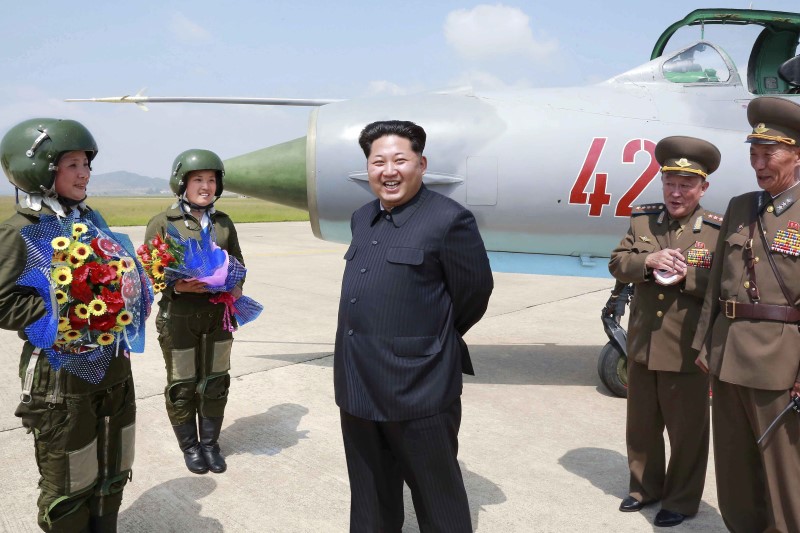By James Pearson (LON:PSON) and Ju-min Park
SEOUL (Reuters) - Like many in North Korea's army of 1.2 million, Eom Yeong-nam spent more time holding the wooden handle of a shovel than a Kalashnikov rifle during his years in the 501 Construction Brigade.
"Except for basic military training two to three months a year, we worked on building apartments or concrete structures for nine to ten months," said Eom, who served 10 years in the army before defecting to the South in 2010, a year before Kim Jong Un assumed power in isolated North Korea.
The young leader has since expanded the use of so-called "soldier-builders", fuelling a construction boom as many of North Korea's Soviet-era conventional weapons become outmoded.
His military focus is increasingly on "asymmetric" capabilities such as nuclear weapons, ballistic missiles and cyber warfare to deter North Korea's main enemies, the United States and South Korea.
Tensions with both have been on the rise since the start of the year.
North Korea, under tightened United Nations sanctions following its fourth nuclear test in January and a space rocket launch the following month, said on Monday it will make a "physical response" to moves by the United States and South Korea to deploy an advanced missile defence system on the Korean peninsula.
North Korea also said on Monday it was cutting off its only channel of communications with the United States following a U.S. decision to sanction Kim Jong Un by name for human rights abuses and base the THAAD anti-missile system in South Korea.
The focus on the asymmetric capabilities has been accompanied by a downscaling of the importance of the military within North Korea's power structure. Slowly, Kim is dismantling the "military first" policy of his late father, Kim Jong Il, and giving precedence to the ruling Workers Party.
This was evident most recently when the National Defence Commission, a military body promoted by Kim's father as one of the highest decision-making institutions in government, was replaced last month by the civilian-heavy State Affairs Commission.
"The KPA (Korean People's Army) is undergoing actual modernization. Kim Jong Un is cutting through some of the fiefdoms and patronage networks that had grown too powerful," said Michael Madden, an expert on the North Korean leadership.
After coming to power, one of the first of Kim's purges was the 2012 removal of Ri Yong Ho, the KPA's then Chief of Staff.
Since then, he has chipped away at the standing of senior military officers, in public.
In 2014, Kim made his admirals take part in a swimming competition on the beaches of his summer palace while he watched, according to state media.
That summer, his air force commanders were made to fly fighter jets as part of a military flying competition, and he instructed his generals to take part in a target shooting competition, state media said.
"Hacks and cronies are out in favour of professional military men," said Madden, adding that such competitions could distinguish genuine officers from those who rose through corruption and patronage.
MILLION MAN ARMY?
While North Korea is often credited with having a "million-man army", many are not combat-ready troops and are instead conscripted for up to ten years at a time, largely as an easily-mobilized source of labour.
There are about 300,000 combat-ready troops, most of them poorly-equipped and concentrated in the area near the inter-Korean Demlitiarised Zone (DMZ), General Vincent Brooks, commander of U.S. Forces Korea, told the U.S. Senate Armed Services Committee earlier this year.
Still, the DMZ is just 40 kilometres from Seoul, which the North occasionally threatens to turn into a "sea of flames".
North Korea has 73 submarines, more than China and far more than the South's 23. Pyongyang's submarines, although ageing Soviet models, are a key part of Kim Jong Un's strategy to mount a nuclear warhead on a submarine-launched ballistic missile.
North Korea also has 21,100 artillery guns, mostly old Soviet-designed weapons, according to the IISS Military Balance, twice as many as South Korea and almost 8,000 more than China.
By comparison, South Korea has 628,000 active soldiers, most of whom are also conscripts, and 4.5 million reservists. North Korea has 5.7 million reservists, according to the IISS Military Balance 2016, most of whom are part of the under-equipped, paramilitary Worker-Peasant Red Guard.
The military's other antique equipment includes the Antonov An-2, a large Soviet transport plane built in the 1940s, used elsewhere as a crop duster, but capable of flying at slow speeds under radar.
The rest of its air force recently had its planes repainted, according to images released by state media, a move which "only disguises the underlying lack of new airframes over the past two decades," according to the Military Balance, a compilation of global military statistics from the International Institute of Strategic Studies.
Still, Kim's army has spent scarce resources to renovate cracked runways at its air bases, invest in island defence units across North Korea's rocky coast, and introduce new tank-training areas, according to satellite imagery analysis by Curtis Melvin at Johns Hopkins University in Washington.
The KPA "lacks the logistical support necessary to sustain a large scale attack," Brooks told the Senate.
Instead, the North is believed to have amassed enough plutonium for as many as 21 nuclear weapons, according to the Washington-based Institute for Science and International Security, and has been accelerating testing of various types of ballistic missiles, all in violation of United Nations Security Council Resolutions.
It is also ramping up its cyber warfare capability, according to the South Korean government.

Along with nuclear weapons and missiles, cyber warfare was now one of North Korea's "omnipotent swords," Kim Jong Un said, according to South Korea's National Intelligence Service.